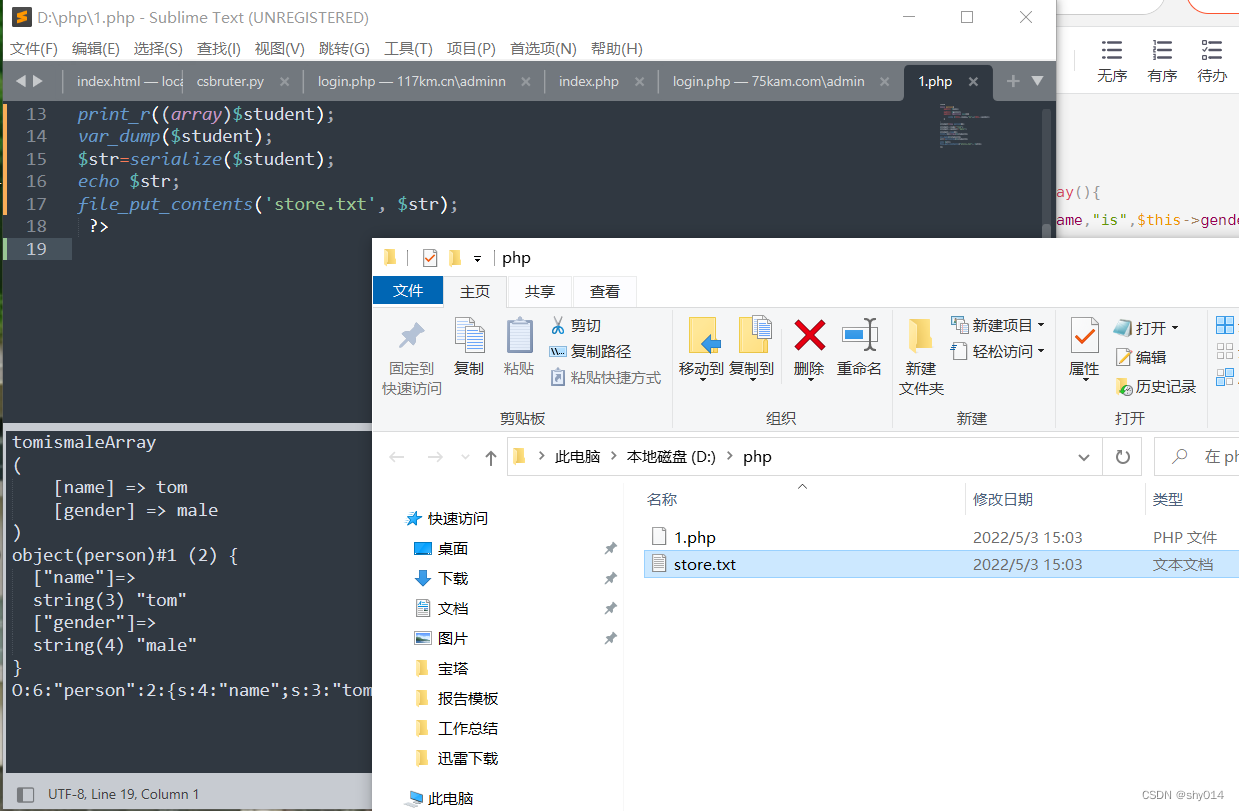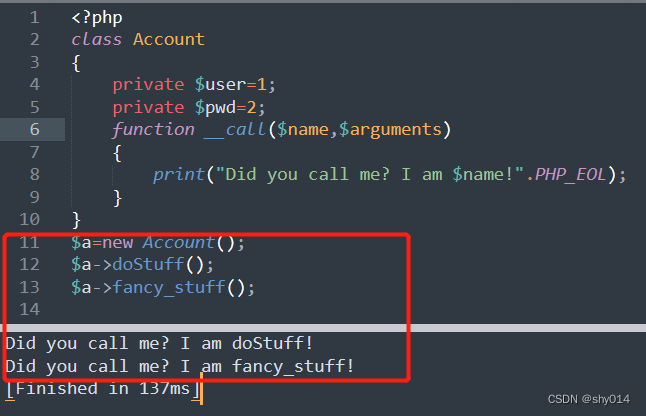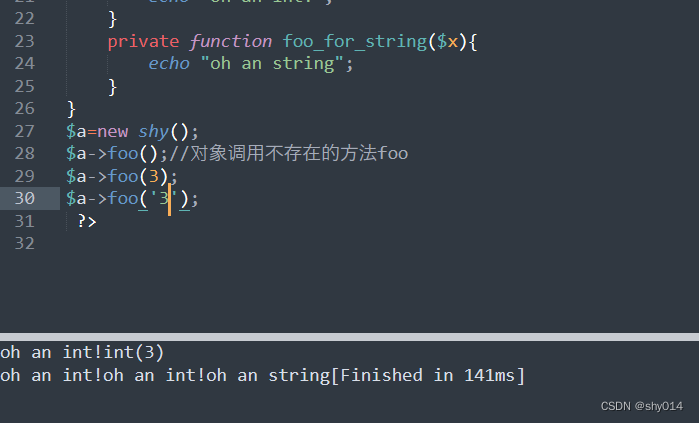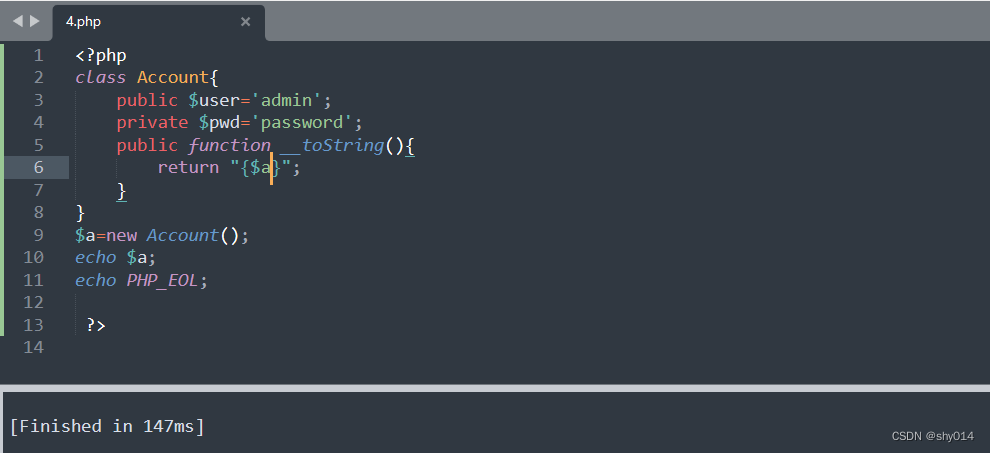1.1 类和对象
定义一个类,并实例化一个对象,给对象赋值,并使对象调用类方法。
<?php
class person{
public $name;
public $gender;
public function say(){
echo $this->name,"is",$this->gender;
}
}
$student=new person();
$student->name="tom";
$student->gender="male";
$student->say();
?>

$str=serialize($student);//将对象序列化
file_put_contents('store.txt', $str);//将序列化后的字符串保存到文本文件中
$str=file_get_contents('store.txt');//从文本文件中读取序列化字符串
$student=unserialize($str);//反序列化
$student->say();//调用方法
序列化后的对象会附带所属的类名,这个类名保证此对象能够在执行类的方法时,可以正确地找到方法所在的代码空间。
<?php
class person{
public $name;
public $gender;
public function say(){
echo $this->name," is ",$this->gender;
}
}
class family{
public $people;
public $location;
public function __construct($p,$loc){
$this->people=$p;
$this->location=$loc;
}
}
$student=new person();
$student->name='Tom';
$student->gender='male';
$student->say();
echo PHP_EOL;
$tom=new family($student,'peking');
echo serialize($student).PHP_EOL;
$student_arr=array('name'=>'Tom','gender'=>'male');
echo serialize($student_arr).PHP_EOL;
print_r($tom);
echo "\n";
echo serialize($tom);
?>
运行结果:

1.2 魔术方法
魔术方法是以两个下划线“__”开头、具有特殊作用的一些方法。
__construct()
构造方法,往往用于类进行初始化时执行一些初始化操作,如给属性赋值、连接数据库等。
$tom=new family($student,'peking');
$tom->people->say();
__set和__get方法
__set和__get是两个比较重要的魔术方法
__set(),设置一个类的成员变量时调用,__set( $property, $value )` 方法用来设置私有属性, 给一个未定义的属性赋值时,此方法会被触发,传递的参数是被设置的属性名和值。
<?php
class Account{
private $user=1;
private $pwd=2;
public function __set($name,$value)
{
echo "设置 $name 的值为 $value \r\n";
$this->$name=$value;
}
$a=new Account();
echo $a->user.PHP_EOL;
$a->name=5;//给一个未定义的属性name赋值的时候触发了魔术方法__set()
echo $a->name.PHP_EOL;
?>
__get(),获得一个类的成员变量时调用
在 php 面向对象编程中,类的成员属性被设定为 private 后,如果我们试图在外面调用它则会出现“不能访问某个私有属性”的错误。那么为了解决这个问题,我们可以使用魔术方法 __get()。
魔术方法__get()的作用
在程序运行过程中,通过它可以在对象的外部获取私有成员属性的值。
<?php
class Account
{
private $user=1;
private $pwd=2;
public function __get($name)
{
if ($name=="user")
{
return $this->user;
}else{
return $this->pwd;
}
}
}
$a=new Account();
echo "user的值为 $a->user";
echo PHP_EOL;
echo "pwd的值为 $a->pwd";
?>
user的值为 1
pwd的值为 2
<?php
class Account{
private $user=1;
private $pwd=2;
public function __set($name,$value)
{
echo "设置 $name 的值为 $value \r\n";
$this->$name=$value;
}
public function __get($name)
{
if(!isset($this->$name))
{
echo '未设置';
$this->$name="正在为你设置默认值";
}
return $this->$name;
}
}
$a=new Account();
echo $a->user.PHP_EOL;
$a->name=5;//给一个未定义的属性name赋值的时候触发了魔术方法__set()
echo $a->name.PHP_EOL;
echo $a->big.PHP_EOL;
?>
__call和__callStatic方法
__call():用来监视一个对象中的其他方法。调用不存在的方法或没有权限的方法,__call 方法将会被自动调用
一、__call的使用
1、调用不存在的方法,报错

2、设置了魔术方法__call,调用不存在的方法doStuff和fancy_stuff的时,执行了__call内的代码。

使用__call实现“过载”动作
<?php
/**
*
*/
class shy
{
function __call($name,$arguments) //由于foo不存在,调用魔术方法__call
{
if ($name='foo')
{
// code...
if (is_int($arguments[0]))
var_dump($arguments[0]);
$this->foo_for_int($arguments[0]);
if(is_string($arguments[0]))
$this->foo_for_string($arguments[0]);
}
}
private function foo_for_int($x){
echo "oh an int!";
}
private function foo_for_string($x){
echo "oh an string";
}
}
$a=new shy();
$a->foo();//对象调用不存在的方法foo
?>
运行结果:

二、__callStatic的使用
方法与上面所说的 __call() 功能除了 __callStatic() 是未静态方法准备的之外,其它都是一样的。
<?php
class shy
{
function say(){
echo "hello,world!".PHP_EOL;
}
public static function __callStatic($funNmae,$arguments){
echo "你所调用的静态方法:" . $funName . "(参数:" ; // 输出调用不存在的方法名
print_r($arguments); // 输出调用不存在的方法时的参数列表
echo ")不存在!<br>\n"; // 结束换行
}
}
$a=new shy();
$a->say();
$a::jkl("teacher");
$a::eat("小明", "苹果");
?>

__toString方法
先看一个代码栗子
<?php
class Account{
public $user='admin';
private $pwd='password';
public function __toString(){
return "当前对象的用户名是{$this->user},密码是{$this->pwd}";
}
}
$a=new Account();
echo $a;
echo PHP_EOL;
print_r($a);
?>
运行结果:

几点思考:
1、直接echo一个对象会导致报错,
2、echo一个对象会调用__toString()方法,
3、和序列化、反序列化有点相似,却又很大程度上不一样,(相似,没有可比性)
一个是将对象变成序列化字符串之后,可以直接echo。
一个是echo对象的时候,调用__toString()方法,然后执行方法内的代码,如果该代码是输出对象的属性,那么可以echo。
验证:可不可以在toString()方法中直接echo对象,

验证结果:不可以。
